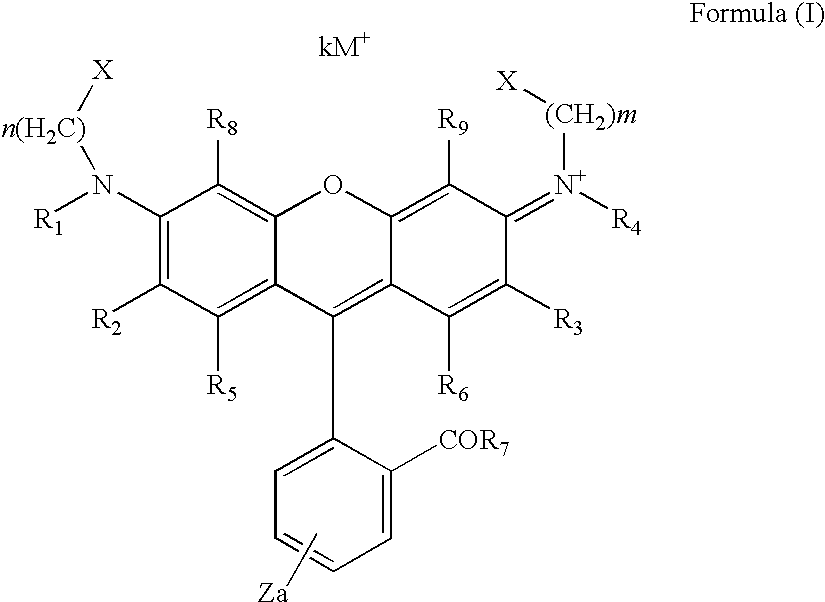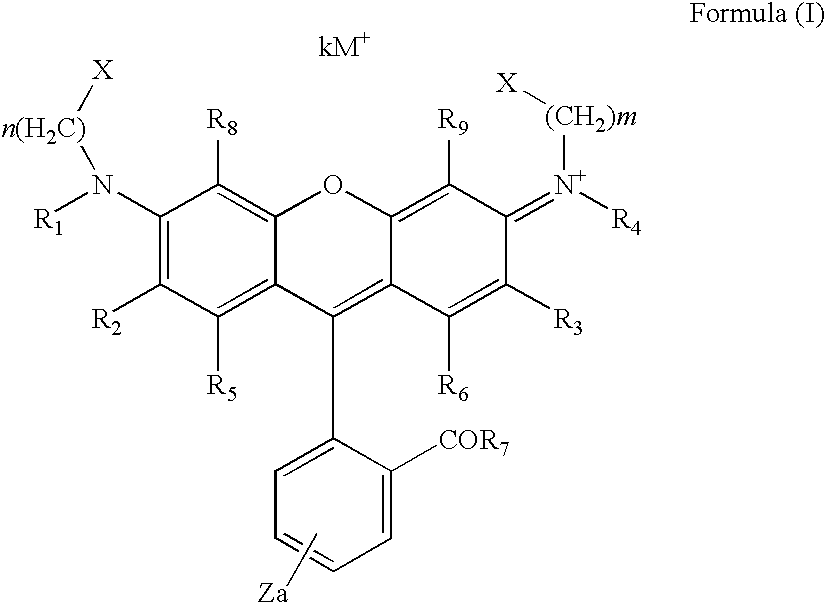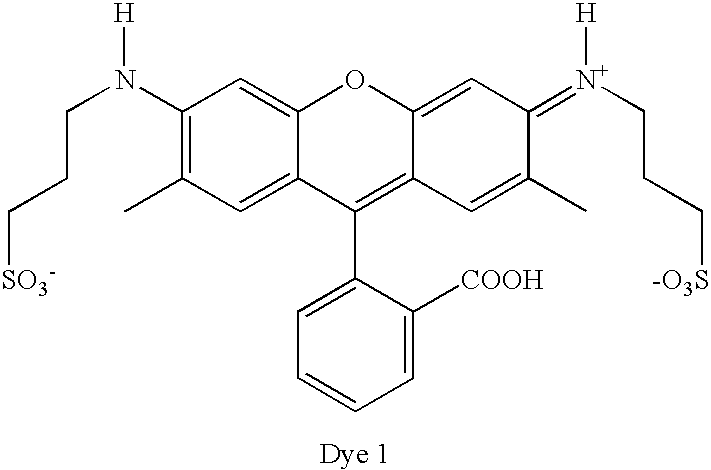Dye Compounds and the Use of their Labelled Conjugates
a technology of dye compounds and conjugates, applied in the field of rhodamine dye compounds, labelled conjugates, can solve the problems of limited shelf life, serious limitations in the use of radioactive isotopes, and their expens
- Summary
- Abstract
- Description
- Claims
- Application Information
AI Technical Summary
Problems solved by technology
Method used
Image
Examples
example 1
Preparation of ‘Dye 1’
[0085]
Step 1
Synthesis of Triethylammonio 3-[(5-hydroxy-2-methyl-phenyl)amino]propanesulfonate
[0086]
[0087]Mixture of 12.3 g (0.1 mol) 3-amino-4-methylphenol, 15 g (1.1 mol) 1,3-propanesultone and 50 ml methanol was stirred for 48 hours. The methanol was evaporated in vacuum, white solid mass triturated with diethyl ether and filtered off. This 3-[(5-hydroxy-2-methyl-phenyl)amino]propanesulfonate suspended in 50 ml of acetone, 10 ml triethylamine was added and mixture stirred overnight. Product filtered off, washed with diethyl ether. Yield 21 g (60.7%)
[0088]Proton NMR (PMR) (CD3OD): 6.97 (1H, d), 6.36 (1H, d), 6.24 (1H, dd), 3.47 (2H, t), 3.37 (6H, q), 3.08 (2H, t), 2.27 (2H, dt), 2.22 (3H, s), 1.47 (9H, t).
Step 2
[0089]
[0090]The reaction was performed according to Example 2; step 3 using triethylammonium 3-[(5-hydroxy-2-methyl-phenyl)amino]propanesulfonate instead of triethylammonium 3-(7-hydroxy-3,4-dihydro-quinoline-1-yl)-propanesulfonate. The reaction mixtur...
example 2
Preparation of ‘Dye 2’
[0111]
Step 1
Synthesis of 3-(7-Hydroxyquinolinio-1-yl)propanesulfonate
[0112]
[0113]This compound is prepared from 7-hydroxyquinoline and 1,3-propanesultone as published (GB 1,122,704) for 3-(8-hydroxyquinolinio-1-yl)propanesulfonate.
Step 2
Synthesis of Triethylammonium 3-(7-hydroxy-3,4-dihydro-quinoline-1-yl)propanesulfonate
[0114]
[0115]To a suspension of 2.67 g (10 mmole) of 3-(7-hydroxyquinolinio-1-yl)propanesulfonate in 500 ml of methanol, 1.5 g of triethylamine was added and stirred 3-5 min until clear solution was prepared. To this solution 0.5 g Ni Raney was added and mixture hydrogenated at room temperature for 3 hours. The reaction mixture was suction filtered through diatomaceous earth and the filtrate evaporated under reduced pressure. The resulting crystallized yellow compound washed with diethyl ether and filtered off. Yield 3.7 g (99%).
[0116]The structure was confirmed by PMR (CD3OD): 6.69 (1H, d), 6.14 (1H, d), 5.97 (1H, dd), 3.38 (2H, t), (2H, t), ...
example 3
9-(2,4-Dicarboxyphenyl)- and 9-(2,5-Dicarboxyphenyl)xanthylium dye 3a,b
[0125]
[0126]Triethylammonium 3-(7-hydroxy-3,4-2H-dihydro-quinoline-1-yl)sulfonate (Example 2, step 2) (0.05 g, 0.13 mmole) was combined with 0.05 g (0.26 mmole) of trimellitic anhydride in 0.5 ml of 1-ethyl-3-methylimidazolium chloride and 0.05 g of anhydrous ZnCl2. The resulting mixture was heated at 120° C. for 0.5 hour then 5 ml of acetonitrile was added to the reaction mixture. The resulting precipitate is filtered, washed with acetonitrile and dried. Yield: 0.05 g. (92%). Isomers separated by HPLC and structure confirmed by NMR and mass-spectra
PUM
| Property | Measurement | Unit |
|---|---|---|
| wavelength | aaaaa | aaaaa |
| wavelength | aaaaa | aaaaa |
| wavelength | aaaaa | aaaaa |
Abstract
Description
Claims
Application Information
 Login to View More
Login to View More - R&D
- Intellectual Property
- Life Sciences
- Materials
- Tech Scout
- Unparalleled Data Quality
- Higher Quality Content
- 60% Fewer Hallucinations
Browse by: Latest US Patents, China's latest patents, Technical Efficacy Thesaurus, Application Domain, Technology Topic, Popular Technical Reports.
© 2025 PatSnap. All rights reserved.Legal|Privacy policy|Modern Slavery Act Transparency Statement|Sitemap|About US| Contact US: help@patsnap.com



